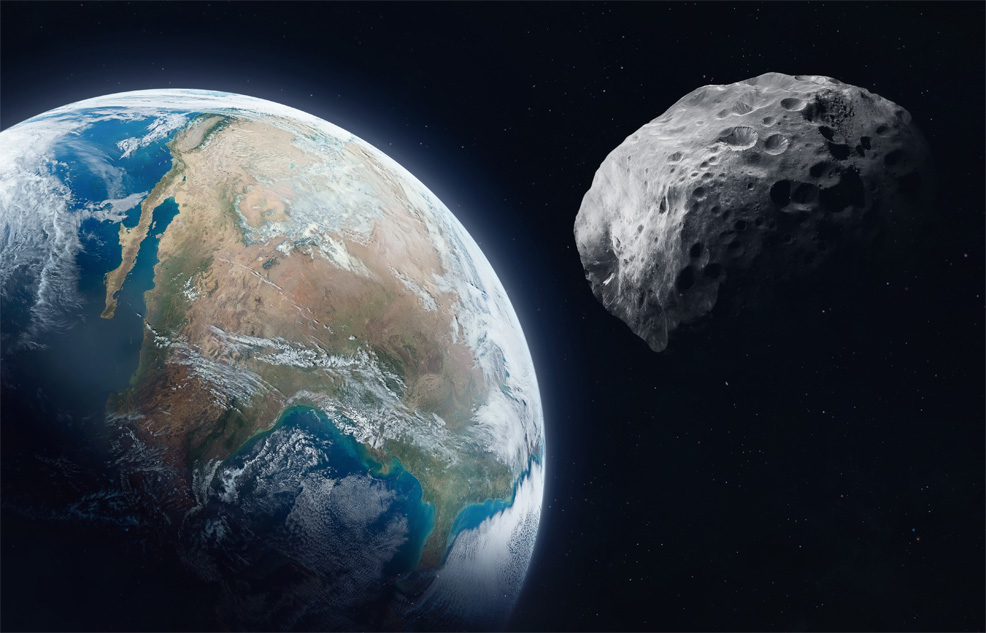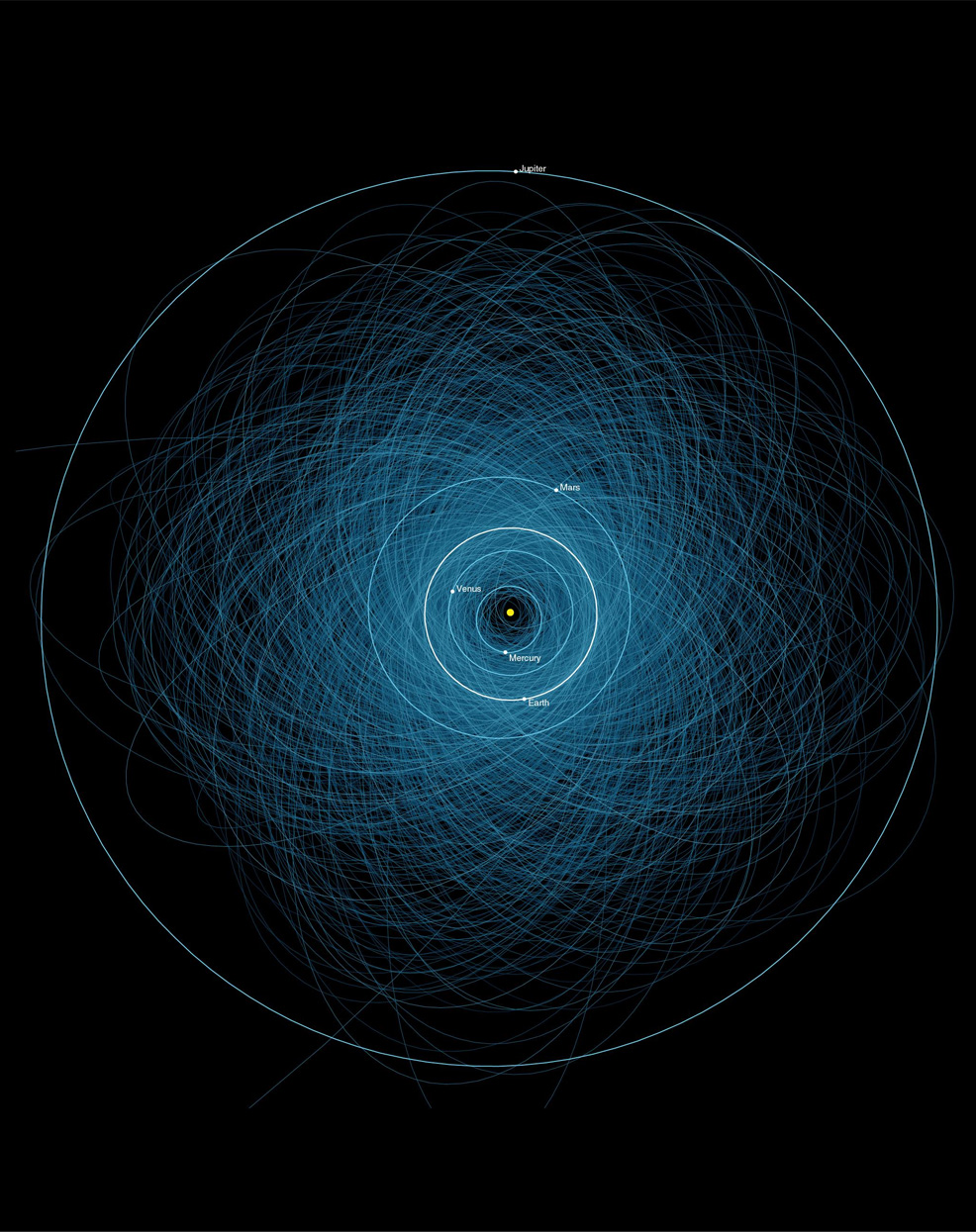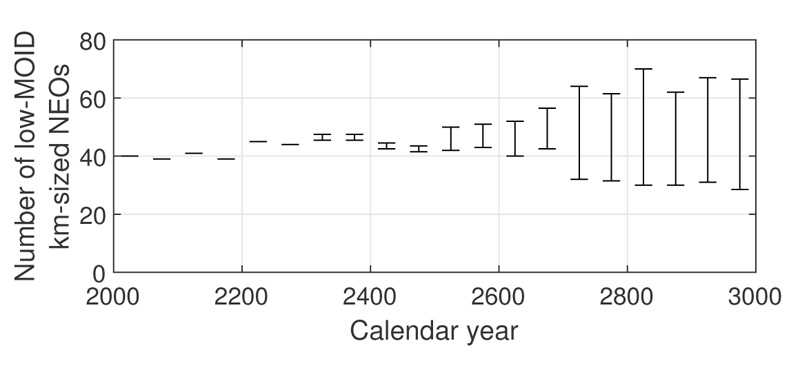
3rd June 2023 The most dangerous asteroids of the next 1,000 years Astronomers have mapped the paths of potentially hazardous 1 km+ asteroids between now and the year 3000 AD. At least 28 are found to have non-zero probabilities of a 'deep encounter' with Earth.
As of today, we know of 878 near-Earth asteroids (NEAs) larger than 1 km (0.6 mi) in size. The Center for Near-Earth Object Studies (CNEOS), which is part of NASA's Jet Propulsion Laboratory, keeps track of these objects, collecting and providing data on those which may be hazardous to Earth. The CNEOS believes that its 1 km+ catalogue, having expanded ten-fold since 1990, is nearing completion with an estimated 96% of all NEAs now identified. When predicting the future orbits of these larger asteroids, the CNEOS and other agencies tend to focus on the next 100 years. Beyond this timeframe, uncertainties become greater and more complex. A variety of factors can contribute to this unpredictability. For instance, small errors in determining an asteroid's initial position, velocity, or other properties can build up substantially over the longer term, a feature of chaotic systems referred to as the "butterfly effect". Gravitational perturbations, especially from planets, can also trigger unforeseen changes. Non-gravitational forces like solar radiation pressure and differences in heat and cold (see the Yarkovsky effect) can influence an asteroid's orbit too. Yet another factor is collisions with other asteroids. While large collisions are relatively rare, even small impacts can have a cumulative effect over lengthy periods of time. Given the various factors that cause uncertainty in calculating the long-term orbits of near-Earth asteroids, ongoing observations and refinements to models are necessary to ensure the most accurate predictions possible.
A group of scientists has proposed a new method to estimate the probability of a close encounter during periods when NEAs are in the vicinity of Earth for longer periods of time. This metric can be used to rank the 1 km+ catalogue in terms of their long-term impact hazard and to identify targets for additional observation and exploration. A study describing their work appears on the arXiv pre-print server and will shortly be published in The Astronomical Journal. The research is led by Oscar Fuentes-Muñoz from the University of Colorado, Boulder. According to his team's analysis, the vast majority of km-sized NEAs can be ruled out as impact threats for the next 1,000 years. However, a small number feature a relatively high probability of a "deep Earth encounter" – meaning they could pass within 0.003 astronomical units (AU) or less than the distance to the Moon. Additionally, many more objects in the class below (140m to 1 km), not included in this study, cannot be ruled out. While unlikely to cause global devastation, these mid-sized asteroids could still produce regional or continental-scale effects if they hit. "Our focus was on the objects larger than 1 kilometre, and we tried to rank them in terms of their associated risk of impact over 1,000 years, which is a longer time span than we usually analyse," explained study co-author Davide Farnocchia, an astrophysicist at NASA's Jet Propulsion Laboratory, California. "There are a few we should continue to keep an eye on, how their orbits could evolve." The team obtained longer-term predictions with refined accuracy by developing a new model, specifically based on the points of an asteroid's orbit when it comes closest to Earth. They looked at something called MOID, which stands for Minimum Orbit Intersection Distance. This value is a measure of how close two objects (i.e. an asteroid and Earth) can get to each other while remaining on their own separate orbits. The MOID is the closest distance between the two orbits at any point in time. By using this metric and analysing its evolution over many centuries, their model reduced the uncertainties and generated a list of probabilities, helping to identify 1 km or larger asteroids posing the greatest danger. As of today, 40 near-Earth objects of 1 km or larger have a MOID of below 0.01 AU. This number is likely to remain stable until the year 2500, after which the model suggests the possibility of an increase that may reach as high as 72 asteroids by the 2800s. Among the high-risk orbits of that time is 1950 DA, with a closest encounter happening in 2880. A decline is also possible, from around the 2700s onward. However, the uncertainty ranges seem to favour a higher number than today, as shown in the graph below.
Overall, the astronomers identified 28 candidates that have a non-zero probability of a "deep encounter," which means they could pass within less than the distance to the Moon. Here, then, are the most high-risk asteroids between now and 3000 AD. A complete list can be found in the team's paper. 7482 (1994 PC1) This object is notable for having sustained a relatively close orbit to Earth for centuries already, which is likely to continue into the far future. Its very low MOID of less than one lunar distance (LD) can be expected for 98% of this millennium. A common S-type (stony) asteroid, its diameter is 1,052m (3,451 ft) and its most recent close approach took place on 18th January 2022 when it passed within 1.2 million miles of Earth. The distance and brightness placed it just outside the reach of common 7×50 binoculars. Currently unnamed, but designated 7482 (1994 PC1), it ranks as the most dangerous object, with much closer encounters possible on numerous occasions in the second half of this millennium. 4179 Toutatis (1989 AC) Second on the list, 4179 Toutatis (1989 AC) is an elongated asteroid with dimensions of 4.75 × 1.95 km (2.95 x 1.2 mi). Its chaotic orbit, slow rotation and irregular shape make it challenging to observe and model. The Chinese lunar probe Chang'e 2 flew by Toutatis in 2012, revealing a dusty red/orange colour and topographical details. Toutatis has a history of close approaches to Earth and will pass within 0.02 AU on 5th November 2069, but a much higher risk encounter will occur in the early 2500s when its MOID is within one lunar distance. 314082 Dryope (2005 CZ36) 314082 Dryope (2005 CZ36) is ranked third on the list. It has a diameter of 1,080m (0.67 mi) and a magnitude of 17.5, making it the darkest of the asteroids described here. At present, the MOID of Dryope is considerably longer (and therefore safer) than the previous two. However, this orbital distance is gradually shrinking over time and will lead to a relatively close pass in 2186. A series of much closer approaches are then predicted later in this millennium and the MOID is likely to remain below 0.01 AU for thousands of years after that.
1 km+ asteroids with highest probability of approaching closer than one lunar distance (LD). Black continuous line shows the nominal trajectory. Close encounters are indicated with circles in colours and close encounters of the nominal trajectory are shown as vertical black nodes. Encounters of closest approach distance (< 1LD, or 0.0026 au) are highlighted with a larger red circle. Years are shown on the x-axis. Credit: Oscar Fuentes-Muñoz, et al.
Comments »
If you enjoyed this article, please consider sharing it:
|










